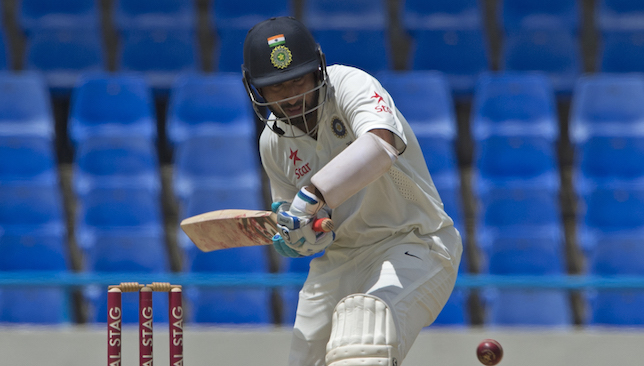
Strike rates have suddenly become a bit of a topic in Test batting. It came to the fore when it was revealed India batsman Cheteshwar Pujara was spoken to by the team management over his slow scoring rate during their recent tour of the West Indies.
In the first two Tests in the Caribbean, Pujara made 16 off 67 deliveries (strike rate 23.88) and 46 off 159 (strike rate of 28.93). What made things look worse for the 28-year-old was the team scored 500 in both those innings. So while the rest of the side batted fairly confidently, Pujara played at his own tempo.
He was replaced for the third Test by Rohit Sharma, who instinctively scores at a high rate if he spends enough time in the middle.
After captain Virat Kohli talked to Pujara about his strike rate, the Saurashtra batsman upped the ante in the domestic Duleep Trophy, registering knocks of 166 off 280 balls and 256 from 363 deliveries. He regained his spot in the Test team and batted with a bit more purpose against the Kiwis.
In his first three innings, Pujara made 62 from 109 balls (SR 56.88), 78 from 152 (SR 51.31), 87 from 219 (SR 39.72) and 41 from 108 (SR 37.96). A definite change in tempo.
“Pujara is someone who absorbs the pressure really well but after a certain stage in the innings there comes a time when the team needs runs,” Kohli had revealed after the Kanpur Test. And this is something Pujara must keep in mind.
He looked a bit coy when asked about the team’s scoring rate on the opening day of the third Test against the Kiwis when they batted at less than three runs an overs despite losing just three wickets.
While it was Kohli and Ajinkya Rahane who did the bulk of the batting, Pujara understood a finger was being pointed at him as well. His defence was positive intent matters as much as a strike rate of more than 60 in Tests.
Pujara and Bhuvi both gave a solid test match performance. But we may drop them both in our lust for quicker runs and faster balls.
— cricBC (@cricBC) October 3, 2016
That is fine in theory but doesn’t always hold true. Former India opener Aakash Chopra can attest to that. He made his India debut in 2003 against the Kiwis and in the Mohali Test, blocked his way to 52 from 160 balls to save the match after India followed on. He then played a critical role in the following tour of Australia, where the smothered the new ball while fellow opener Virender Sehwag went about taking the Aussie bowling apart.
Chopra had knocks of 36 from 135 balls, 48 from 138 and 45 from 139 deliveries to his name on the Australia tour. And when the runs dried up during 2004, he was dropped from the side once and for all.
A perception had formed that Chopra could only bat a certain way and couldn’t be relied upon to score big. It didn’t matter that he had been given a specific role to see out the new ball. When he had the opportunity, he didn’t convert those starts and no century in 19 innings and a career strike rate of 34.6 eventually worked against Chopra.
Pujara must remember that while he is the No. 3 batsman and needs to be solid at that critical position, the dynamics of Test cricket have changed. If batsmen face a certain number of deliveries, they are expected to pile on the runs at some stage. It is why Kohli wants to have Rohit in the team because if he bats for 150 balls, his score will be closer to 100 than 50.
There is something more important that intent and that is runs on the board. Teams all over the world have clear plans – bat for around 150 overs if the going is good and give your bowlers the maximum amount of time to enforce a result.
A positive result is the ultimate result with a quick 40 as valuable as a long drawn 70. There was a time when the ability to stop the ball at your feet with a forward defence was seen as a virtue. Now it is looked at as a wasted run.
What’s going in Pujara’s favour is that he is scoring decent runs. But his captain demands more from his wards. Kohli wants to play a certain brand of cricket and if Pujara can show a bit more urgency with the bat, he will be able to lock down his position in the line-up.
He has the technique and the temperament to keep the scoreboard ticking, like Kohli and Rahane do with regularity. He just needs to accept that it’s a necessity and not a luxury.
India spinner Ravindra Jadeja was fined 50 per cent of his match fee for running down the middle of the pitch multiple times while batting despite being warned by the umpires during the Indore Test.
When the Kiwis began their innings, they had five runs on the board even before facing a ball as the umpired awarded them penalty runs for Jadeja’s indiscretions.
While Jadeja can’t be accused to deliberately trying to damage the pitch, I feel the cost associated with such an act isn’t steep enough to deter teams. Once damage has been done to the pitch, it can influence the fall of wickets.
A better penalty would be stopping a batsman from taking any further part in the innings. Because a penalty of even 20 runs doesn’t matter in the grand scheme of things.